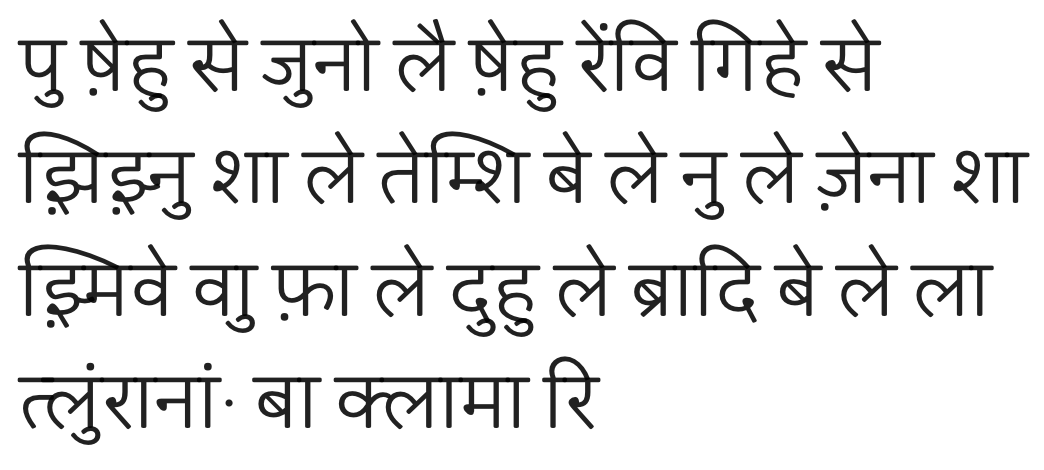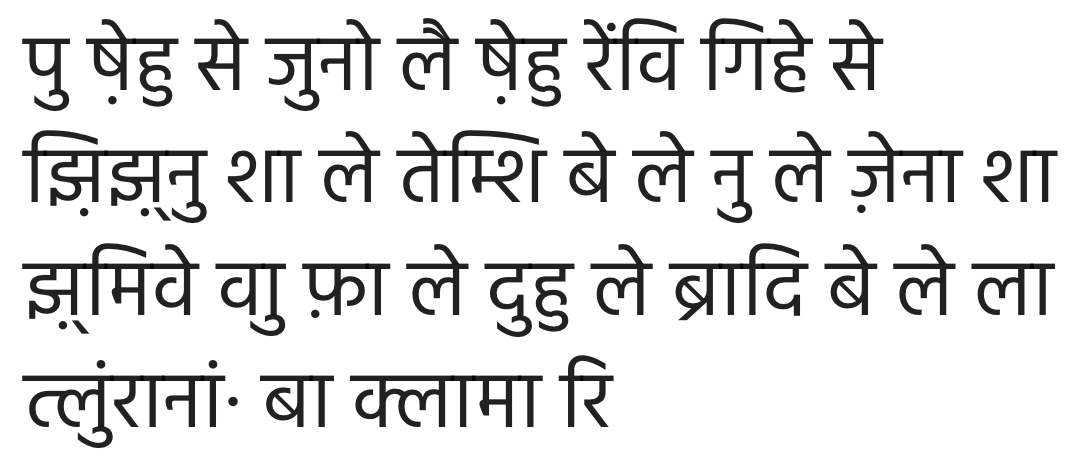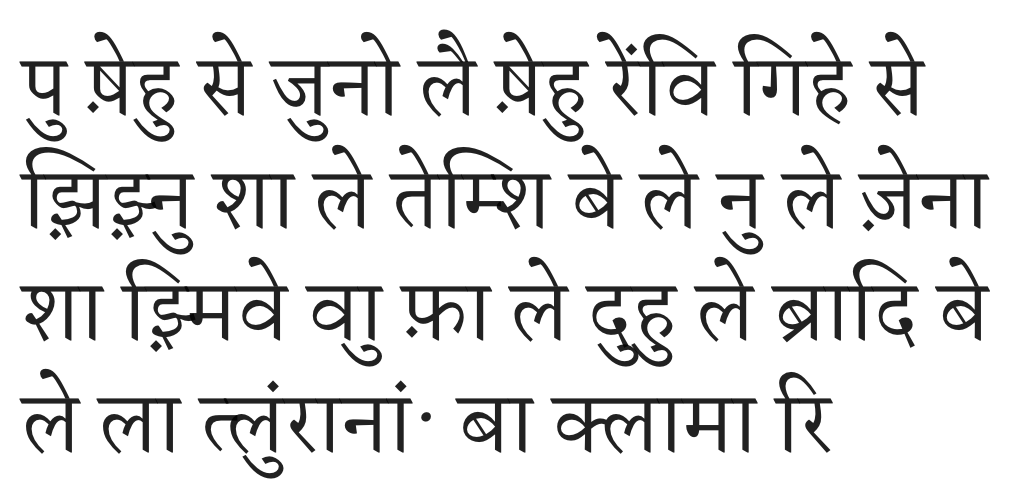ख़िंलेर्मोर्ना - xinlermorna
2019/09, revision: 2019/10
By: la vitno, Version: ख़िं 0.6 , PDF: xinlermorna-V0.6.pdf
Devanagari Orthography for Lojban based on Hindi pronunciation
Tables
Consonants
Note: all the inherent vowels /ə/ are reserved as y in Lojban, suppressing is not allowed without being explicitly marked as such (with ्) or being the last letter of word.
| Latin | देवनागरी |
|---|---|
| c | श |
| j | झ़ |
| s | स |
| z | ष़ * |
| f | फ़ |
| v | व |
| x | ख़ |
| ' | ह |
| r | र |
| l | ल |
| n | न |
| m | म |
| b | ब |
| d | द |
| g | ग |
| k | क |
| p | प |
| t | त |
| dj | ज |
| tc | च |
| dz | ज़ * |
| ts | च़ |
* letter ष़ /ɭə/ is assigned the value /zə/
* letter ज़ /zə/ is assigned the value /ʣə/
Vowels
| Latin | देवनागरी (Indepdt. Form) | देवनागरी (Diacritic Form) | देवनागरी (Diacritic Form with 'k/क') |
|---|---|---|---|
| a | आ | ा | का |
| e | ए | े | के |
| i | इ | ि | कि |
| o | ओ | ो | को |
| u | उ | ु | कु |
| y | अ | (inherent) | क |
Diphthongs
When used alone, diphthongs can be written as Vowel Independent Form or Diphthong Independent Form, they are All Accepted
When i (इ) is written as first letter in diphthongs, the following vowel should always be written as the Independent Form (e.g. आ instead of the Diacritic Form ा). By this way, we are able to seperate words start with kai... (काि...) the ones start with kia... (किआ...). If not, we will get kai... (काि...) and kia... (किा...), which is hard to tell the differences by a normal human.
| Latin | देवनागरी (Vowel Indepdt. Form) | देवनागरी (Diphthong Indepdt. Form) | देवनागरी (Diacritic Form) | देवनागरी (Diacritic Form with 'k/क') |
|---|---|---|---|---|
| ai | आइ | आि | ाि | काि |
| ei | एइ | एि | ेि | केि * |
| oi | ओइ | ओि | ोि | कोि |
| au | आउ | आु | ाु | काु |
| ia | इआ | इा | िआ | किआ |
| ie | इए | इे | िए | किए |
| ii | इइ | ई | ी | की |
| io | इओ | इो | िओ | किओ |
| iu | इउ | इु | िउ | किउ |
| ua | उआ | उा | ुा | कुा |
| ue | उए | उे | ुे | कुे |
| ui | उइ | उि | ुि | कुि |
| uo | उओ | उो | ुो | कुो |
| uu | उउ | ऊ | ू | कू |
| iy | इअ | इअ | िअ | किअ |
| uy | उअ | उअ | ुअ | कुअ |
* When kei is written in as केि, it may not be rendered properly by every font. Hence, Devanagari Vowel ai (ऐ / ै) is also acceptable to be used as ei, so kei can also be written as कै.
Conjunct Consonants
Consonants lacking a vowel in between them MUST physically join together as a conjunct consonant.
| Latin | देवनागरी (GOOD) | देवनागरी (BAD) |
|---|---|---|
| lojban | लोझ़्बान | लोझ़बान = lojyban |
| kanla | कान्ला | कानला = kanyla |
| ckaji | श्काझ़ि | शकाझ़ि = cykaji |
| klama | क्लामा | कलामा = kylama |
| bajra | बाझ़्रा | बाझ़रा = bajyra |
Anusvara
When consonant n is preceded with a vowel and followed with a consonant (e.g. kanla), you can use a diacritic dot (which is called Anusvara: ं) to mark it instead of the independent form n (न), write with Anusvara or Independent Form are Both Accepted
| latin | देवनागरी (Indepdt. Form) | देवनागरी (Anusvara) |
|---|---|---|
| kanla | कान्ला | कांला |
| condi | शोन्दि | शोंदि |
| panci | पान्शि | पांशि |
Text Examples
| Name | Text Sample |
|---|---|
| Standard Orthography | pu ze'u se djuno lei ze'u renvi gi'e se jijnu ca le temci be le nu le dzena ca jmive vau fa le du'u le bradi be le la tlunranan. ba klama ri |
| xinlermorna | पु ष़ेहु से जुनो लै ष़ेहु रेंवि गिहे से झ़िझ़्नु शा ले तेम्शि बे ले नु ले ज़ेना शा झ़्मिवे वाु फ़ा ले दुहु ले ब्रादि बे ले ला त्लुंरानां· बा क्लामा रि |
* Text Sample Source comes from "How the enemy came to Thlunrana": https://jbotcan.org/lojban/en/how-the-enemy-came-to-thlunrana/
Pictures with Different Fonts
* Jaldi https://fonts.google.com/specimen/Jaldi
* Hind https://fonts.google.com/specimen/Hind
* Martel https://fonts.google.com/specimen/Martel
You can try it with the xinlermorna transliteration tool.



